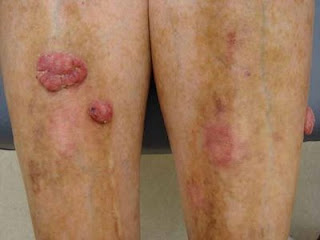We presented this patient around a year ago (she is patient # 2). The woman, now 19 years old, presented in March of 2008 for a keloidal scar in the left triangular fossa. On 12/18/08 based on suggestions and a report in MEDLINE, the lesion was shave excised and a week after surgery, imiquimod was applied nightly for six weeks. She is now one month out after stopping imiquimod. At this point, she looks very good. We will have to see if this is a long term solution.
Reference:
1. Berman B, Kaufman J. Pilot study of the effect of postoperative imiquimod 5% cream on the recurrence rate of excised keloids. J Am Acad Dermatol. 2002 Oct;47(4 Suppl):S209-11.
New adjunctive treatments are needed to reduce the high recurrence rates (50%) of excised keloids. Interferon alfa injections have been shown to decrease the size of stable keloids. This study examined the effects of postoperative imiquimod 5% cream on the recurrence of 13 keloids excised surgically from 12 patients.Starting on the night of surgery, imiquimod 5% cream was applied for 8 weeks. Patients were examined at weeks 4, 8, 16, and 24 for local erythema, edema,
erosions, pigment alteration, and/or recurrence of keloids. Of the 11 keloids evaluated at 24 weeks, none (0%) recurred. Incidences of hyperpigmentation were 63.6%. Two cases of mild irritation and superficial erosion cleared withtemporary discontinuation of imiquimod. Both patients completed the 8 weeks of topical therapy and the final 24-week assessment. At 24 weeks, the recurrence rate of excised keloids treated with postoperative imiquimod 5% cream was lower than recurrence rates previously reported in the literature.


